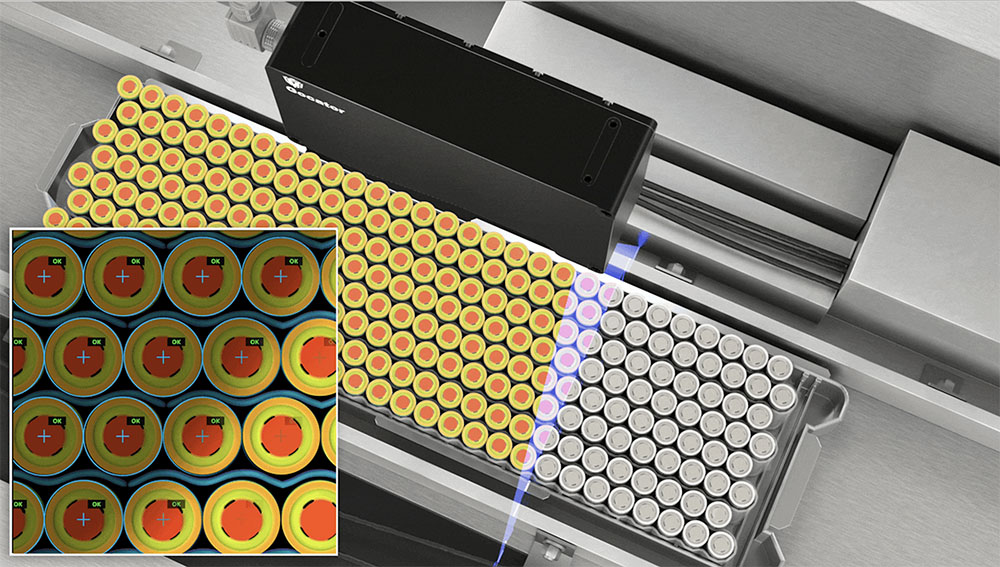
[ad_1]

Sponsored by LMI.
The rise in demand for EV Batteries has already completely remodeled the automobile manufacturing panorama, with nearly all main automotive corporations now working electrical automobile manufacturing strains.
Whereas electrical autos do have much less shifting elements than their inner combustion engine (ICE) counterparts, manufacturing them continues to be extraordinarily advanced. From stators and rotors, to intricate wiring harnesses, LMI is concerned with many EV manufacturing functions. However the coronary heart of an EV is its battery, and that is the place machine imaginative and prescient options have change into important to market success.
EV Battery Manufacturing Overview
EV battery manufacturing might be damaged up into 5 common steps: (1) electrode manufacturing, (2) cell meeting and packaging, (3) cell-to-module meeting, (4) module-to-pack meeting, and (5) closing set up inspection.
Gocator 3D good sensors and their inbuilt, onboard measurement instruments are utilized in each stage of this manufacturing course of.
Let’s take a look at these functions individually.
Electrode Manufacturing
Electrode slurry is coated onto copper and aluminum foil to facilitate electrical move. The metallic floor, separator, and coating should be inspected for edge defects in addition to uniform form and thickness.
Throughout this step, Gocator sensors are used to make sure uniform form and thickness of the electrode because the slurry is utilized. Sensors are additionally used to measure the space between tabs on a cell sheet. Tolerances are extraordinarily small for these functions so excessive decision and small area of view sensors are used.
Sensible 3D sensors are used for various duties at this section of inspection together with:
- Electrode Width Gauging – Correct width gauging of the size of the separator and electrode.
- Electrode Edge Profile Measurement – Excessive-speed profiling of the perimeters of coated electrode sheets to make sure the proper dimensional tolerances are met.
- Tab Distance Gauging – Scanning and measurement of the space between tabs on a cell sheet to satisfy dimensional tolerances.
Cell Meeting and Packaging
A separator and electrode are joined collectively, and the joined cell (together with anode and cathode) is both wound, rolled, or stacked. Stacked cells are then housed in a metallic casing and sealed by welding.
Two of the most typical cell varieties utilized in electrical autos are cylindrical and prismatic. Cylindrical cells are packed collectively into teams and scanned for presence/absence, right place and dimensions, as in addition to for potential floor defects reminiscent of any dents or scratches on the cell prime. Solely 3D supplies the form (peak) knowledge required to examine battery floor options and dimensions for defects reminiscent of bulges, fissures, warps, and extra.

Previous to welding, a Gocator® or multisensor community delivers high-speed 3D laser profiling and a built-in instrument to measure the hole & flush between the prismatic battery cell and its metallic casing. After welding, they’re inspected once more to make sure that the weld seam is uniform and inside tolerances.
The floor of the battery cell must be inspected for proper dimensions and to detect defects of the face, edges, and corners. It’s also price noting that good 3D sensors like Gocator include blue laser mannequin choices. The shorter-wavelength blue gentle generates higher-quality scan knowledge (i.e., much less noisy) on extremely specular battery surfaces reminiscent of polished metallic.
Cell-to-Module Meeting
As soon as the person battery cells are inspected for high quality management, a set variety of them are exactly grouped collectively to type a battery module. An instance software for module inspection is for sensors to measure and examine the weld seams of every module.

Module-to-Pack Meeting
Modules are then mixed to type battery packs. Gocator sensors are used on the closing stage of the method, combining modules right into a single battery pack, able to be put in into a brand new electrical automobile. It’s essential to measure and examine its size, width, peak, and flatness of every floor to make sure that all dimensions are matching the GD&T design tolerances.
Remaining Set up Inspection
In electrical autos, a big tray/pan sits beneath the ground panel. The lithium-ion battery pack is glued to this tray. Gocator sensors are used at this closing stage to examine the glue bead software for proper dimensions (peak, quantity, width, size) and floor high quality (breaks, gaps, overflow and many others.).
Selecting the Proper 3D Sensor for Your EV Battery Utility
LMI Applied sciences gives a variety of laser profile sensors that may deal with any EV battery inspection software. For instance, the Gocator 2500 Collection gives extremely high-speed blue laser profiling for high-performance inspection of shiny EV battery surfaces. Or when even larger measurement precision is required, engineers can deploy the Gocator 2600 Collection of their manufacturing strains for highly effective extremely high-resolution 4K+ profiling.
Mix Sensible 3D Scanning with AI-Primarily based Inspection
Along with its suite of high-speed, high-resolution 3D good sensors for EV battery scanning (with net browser interface and onboard software program), LMI Applied sciences additionally supplies inspection engineers with the choice so as to add highly effective FactorySmart AI-based inspection to their EV Battery manufacturing strains for essentially the most full end-to-end resolution in the marketplace as we speak.
For instance, in EV battery array inspection, engineers can deploy a set of tightly built-in LMI merchandise from sensor {hardware} to edge units and human-machine interface (HMI) in an effort to remedy the applying with most efficiency and cost-efficiency.
An instance of this resolution may embody:
- 2x Gocator 2600 laser profilers for 4K+ high-resolution 3D level cloud era of the EV battery array
- 2x GoMax NX edge units for sensor acceleration and highly effective AI-based floor defect detection
- GoFactory interface for knowledge administration (efficiency monitoring, telemetry dashboarding, configurable alerts)
Conclusion
EV battery manufacturing continues to develop quickly around the globe. LMI isn’t solely supporting the present trade, however actively growing subsequent era sensors particularly designed to satisfy future battery manufacturing wants.
For extra info go to our EV Battery Business net web page.
[ad_2]